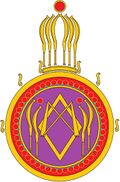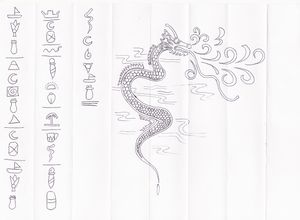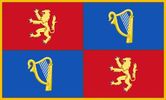Monarchy of Wilcsland
| King of Wilcsland | |
|---|---|
| Former Monarchy | |

| |
| Arms of Wilcsland | |

| |
| Last Monarch: Ptolemy II and John II | |
| First monarch | Ptolemy I |
| Last monarch | Ptolemy II and John II |
| Monarchy started | 1 May 2002 (South Bank) |
| Monarchy ended | 31 December 2019 |
The Wilcslandian monarchy was the absolute monarchy ruling over the Kingdom of Wilcsland. King Declan I, II & V, known in Wilcsland as Ptolemy I, reigned as monarch of Wilcsland and its predecessor states from 1 May 2002 (with an interruption of one week in the summer of 2006) until he was overthrown by his brother, Ptolemy II, at the close of 2014.
The ceremonial full title of the king, used only in their full style, was King of Wilcsland, Taklamacan, the Midway Hills, Frozen Alters and Corran. This was at times supplemented with the titles King of New Wessex, King of Thebes, and/or King of Saqqara.
Role
The King undertook various official, ceremonial and representational duties. As an absolute monarch, the King held absolute power over all executive, legislative, and judicial matters. The King was the main representative of Wilcsland in foreign affairs, and held total control over all domestic governance, appointing members of government and bestowing and revoking titles of nobility.
Despite the power that the King had over the nation, it was held only through the will of the people. Declan I while King of Moylurg would declare "my people are my care" and "I work for you, not you for me". Although absolute, the Wilcslandian monarchy was founded on the theory of the complete delegation of popular sovereignty. This was especially apparent in November 2010, when Moylurg transitioned into Wilcsland; King Jonathan I, titular joint King, was not deposed by King Declan I as they held nominally equal power, but was instead deposed by an assembly of the people who were displeased at having a foreigner share the rank and title of Declan I.
History

The Wilcslandian monarchy traced its origins from the monarchies of the Kingdom of South Bank, the Kingdom of Corran, and the Kingdom of Moylurg. South Bank, founded in May 2002, transitioned into the Kingdom of Atlantis in September 2003, and then in October 2005 transitioned into the Kingdom of the Taklamacan. The Kingdom of Corran was created by the King of the Taklamacan in late 2007, and the Kingdom of Moylurg in June 2009. The Taklamacan unified with Moylurg and Corran in March 2010 to create the Empire of Moylurg; for roughly a month, the monarch claimed the title of Emperor instead of King, but in April 2010 the Empire transitioned back into a Kingdom. This unifed Kingdom then transitioned into the Kingdom of Wilcsland in November 2010. Shortly afterwards, in February 2011, Declan I changed his regnal name in Wilcsland to Ptolemy I (although he remained known as Declan I in his foreign realms), and claimed the title of Pharaoh for the Wilcslandian throne (a move which would be quietly reversed by his brother).
The King of Wilcsland at various times also held the thrones of several other realms and nations, holding these thrones in either political or personal union (often with very little practical difference). The kingdoms of Saqqara and Thebes were sub-kingdoms of the Wilcslandian monarchy since Saqqara was founded by and Thebes was conquered by the Kingdom of Atlantis in late 2003. With the founding of New Wessex (see below) in January 2012, Thebes was abolished as a subkingdom and fully merged into Wilcsland, with the same happening to Saqqara around June 2013.
All of the Carshalton Nations were under the rule of the Wilcslandian monarch between December 2010 and January 2013. Declan I took advantage of an interregnum in the Kingdom of the Grove to unify it with Copan, founding the Tsardom of Orly and provoking the Carshaltonian overlord, Emperor Esmond III of Austenasia, into starting the War of the Orlian Reunification. A local nation allied with Orly, the Midget Nation-in-Exile, declared Declan I to be the Fifth Midget Master upon the instigation of the then Crown Prince Jonathan, entering the Midget Nation into personal union with Wilcsland. With the support of the Midgets and the orchestration of the Crown Prince, the forces of Declan I were able to defeat those of Esmond III, and Declan I was declared joint Emperor of Austenasia and King of Rushymia. On 14 January 2012, Declan I (by then known as Ptolemy I in Wilcsland) declared the creation of the United Kingdom of New Wessex as a political union between Wilcsland and Orly, with the two becoming the constituent countries of the new union.
Declan abdicated from the Austenasian and Rushymian thrones on 20 January 2013. On 24 June 2013, Orly seceded from New Wessex in an event known as the Liberation of Orly. No longer Emperor, the Orlian population no longer had a reason to respect the authority of Declan I and so turned to his successor as such, Emperor Jonathan I, to appoint native monarchs under Austenasian suzerainty as had been the original practice. Declan I abandoned any claims to sovereignty over Orly and relinquished his claim to the title "King of Orly" after being persuaded that there was no support for his reign there to continue.
On 31 December 2014, Declan's brother Prince Ciaran declared himself the new King of Wilcsland as King Ptolemy II, overthrowing his brother who by this point had moved away from his lands to London resulting in the near-collapse of the kingdom. Ptolemy II formally dissolved the defunct "union" of New Wessex, and arranged for Wilcsland to become a protected state of the Empire of Austenasia, but had otherwise inherited an impossible situation. The new king was unable to overcome the challenges faced by his kingdom, and what little remained of Wilcsland soon fell apart. The only major action taken by Ptolemy II was to appoint the now Vera Hewitt his co-monarch as King John II on 30 April 2015. After nearly five years of titular reign by the two, Wilcsland was officially dissolved by John II on 31 December 2019, resulting in the end of the monarchy.
Co-monarchs, usurpers, and vassal monarchs
The reign of Declan I saw several usurpers, as well as the appointment of many vassal and co-monarchs. King-Regents and Queen-Regents were co-rulers that, while sharing the royal style and powers of the King proper, were titularly subservient to him and could be deposed by him at any time. There were only two co-monarchs to have had nominally equal power to Declan I and his brother, namely Jonathan I (of Moylurg) and John II (of Wilcsland), who were both referred to as "King" rather than "King-Regent". In the case of Jonathan I, although his appointment was titular and power nominal, he had to be deposed by an assembly of the people rather than his co-ruler due to his equal status.
Subordinate co-monarchs were titled as "King/Queen-Regent" because of a spelling mistake made upon the appointment of Frances I in 2009, which simply became standardised. The title "Queen Regnant" had been intended, to specify that she was an actual monarch and not the consort of Declan I.
Co-monarchs
Those raised to the throne alongside Declan I and Ptolemy II:
- Frances I, Empress-Regent of Deleckshum and Queen-Regent of Moylurg: 10 July 2009 (Deleckshum)/11 September 2009 (Moylurg) - 13 October 2009
- Laura I, Queen-Regent of Moylurg and Queen-Regent of Corran: 9 February 2010 - 7 March 2010 (Corran)/1 May 2010 (Moylurg)
- Jonathan I, King of Moylurg: 19 October 2010 - 10 November 2010
- Frances I/Arsinoe I Selene, Queen-Regent of Wilcsland: 17 November 2010 - 15 February 2011
- Ptolemy II Alexander II, King-Regent of Wilcsland: 15–16 February 2011
- Berenice I, Queen-Regent of Wilcsland: 16 February 2011
- Arsinoe II Cleopatra I, Queen-Regent of Wilcsland: 16–21 February 2011
- Ptolemy III Helios II, King-Regent of Wilcsland: 21 February 2011 - 12 March 2011
- Arsinoe III, Queen-Regent of Wilcsland: 27–31 August 2011
- John II, King of Wilcsland: 30 April 2015 - 31 December 2019
Usurpers
Those who proclaimed themselves monarch and attempted to overthrow Declan I:
- Barry I of South Bank: Took over the northern half of South Bank during June 2002. Defeated in a civil war.
- Alexander I of the Taklamacan: Seized control over half of the Taklamacan for a short period of time in late 2005. Rebellion crushed.
- Pope Alexander I: Led a conspiracy to become monarch in late 2005, and attempted to take over the Taklamacan in early 2010. Arrested for treason both times before he could seize power.
- Joshua I of the Taklamacan: Successfully removed Declan I completely from power. Held the throne for a week of chaos before Declan I retook the throne.
- Joshua II of the Taklamacan: Took over half of the Taklamacan for a short period of time in early 2007. Surrendered after a brief civil war.
Vassal monarchs
Those who ruled over the sub-kingdoms and vassal monarchies of Wilcsland, its predecessor states, and New Wessex:
- John I, King of Saqqara: October - November 2003, ruled over Saqqara as a vassal to the King of Atlantis.
- Unknown monarch(s) of Corran: Late 2007 - October 2009, ruled over Corran as a vassal to the King of the Taklamacan.
- Ciaran II & III, King of Thebes: 5 March 2010 - 1 May 2010, ruled over Thebes as a vassal of the King/Emperor of Moylurg.
- Declan I, Tsar of Orly: 8 December 2010 - 14 January 2012, ruled over Orly, technically as a vassal to himself as King of Wilcsland.
- Frances I, Tsarina of Orly: 8 December 2010 - 15 February 2011, ruled over Orly as a vassal to the King of Wilcsland.
- James I & IV, King of Thebes: 18 December 2010 - 10 February 2011, ruled over Thebes as a vassal of the King of Wilcsland.
- Calum I, King of the Grove: 13 January 2011 - 14 January 2012, ruled over the Grove under the Viceroy of Orly and as a vassal to the Tsar of Orly (himself a vassal of the King of Wilcsland).
- Ptolemy I Alexander, Tsar of Orly: 15–16 February 2011, ruled over Orly as a vassal to the King of Wilcsland.
- Berenice I, Tsarina of Orly: 16 February 2011, ruled over Orly as a vassal to the King of Wilcsland.
- Arsinoe I Cleopatra, Tsarina of Orly: 16–21 February 2011, ruled over Orly as a vassal to the King of Wilcsland.
- Ptolemy II Helios, Tsar of Orly: 21 February 2011 - 12 March 2011, ruled over Orly as a vassal to the King of Wilcsland.
- Miles, Prince of Copan: 8 March 2011 - 24 April 2011, ruled over Copan under the Viceroy of Orly and as a vassal to the Tsar of Orly (himself a vassal of the King of Wilcsland).
- Joseph, Prince of Copan: 24 April 2011 - 2 August 2011, ruled over Copan under the Viceroy of Orly and as a vassal to the Tsar of Orly (himself a vassal of the King of Wilcsland).
- Esmond, Prince of Copan: 2 August 2011 - 14 January 2012, ruled over Copan under the Viceroy of Orly and as a vassal to the Tsar of Orly (himself a vassal of the King of Wilcsland).
- Arsinoe II, Tsarina of Orly: 27–31 August 2011, ruled over Orly as a vassal to the King of Wilcsland.
- Ptolemy IV, King of Saqqara: 19 September 2011 - 24 June 2013, ruled over Saqqara as a vassal to the King of Wilcsland.
Arms
The Royal Standard of New Wessex is the flag used by the King or Queen in their capacity as monarch.
|
The Royal Standard depicts the central part of the Wessaxon coat of arms - that is, four quadrants, depicting in the first and fourth quarters a lion rampant (the national animal, and to represent the English origins of New Wessex) and depicting in the second and third quarters a Cláirseach (Irish harp) to represent the Irish heritage of the House of Mac Donnchadha-Houghton.
 |
General
Administrative regions
Wilcsland • Orly • Saqqara • New Wiltshire Former states
Monarchs
Declan I, II & V • Nectombetec I • Djoser I/A • Olcut I/A • Temecbo • Telecbo • Olcut II the Great • Olcut III/C • Djoser II/B • Tupo • Barry I • John I • Kieran I & I • Alexander I (usurper) • Joshua I • Other notable people
Locations and monuments
|
